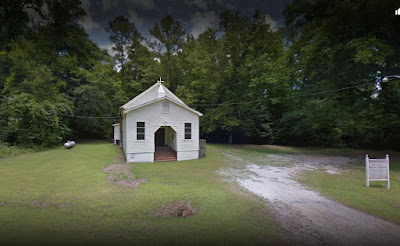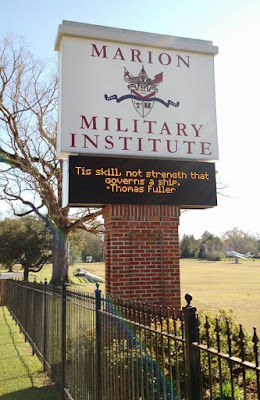A sleepy exterior belies a turbulent civil rights history.
| Siloam Baptist Church, by Carol L. Douglas. |
In the earliest days of social media, ‘stranger danger’ took the form of warnings about people on the internet. When I befriended a Southern Baptist preacher online, my kids were horrified. Facebook came along, and Pastor John Nicholson posted photos of Marion, AL, and historic Siloam Baptist Church. He told me that I really ought to come down and paint there someday. Yesterday, I did.
The city of Marion’s population is about the same as that of Rockport, ME, but it is able to spread out on a neat grid of streets. There are some terrific, large, old houses here, and like everything else, they have elbow room. The pastor’s home is a massive old place; so is the church itself. Built in the boom times, it could seat five hundred worshippers.
| The chair of the art department at Judson College told me a little about this area’s civil rights history, and gave me this book. |
This is the center of Alabama’s Black Belt. This originally referred to the region’s rich, black topsoil. With the development of 19th century cotton plantations, the term started to refer to African-American slaves as well. After the Civil War, freedmen stayed as sharecroppers and tenant farmers. Perry County, of which Marion is the seat, is almost 70% black.
Jimmie Lee Jackson was a young civil rights activist and deacon at St. James Baptist Church here in Marion. On February 18, 1965, he was beaten and shot by troopers while protesting. Eight days later, he died in hospital in nearby Selma. This was the catalyst for the first Selma to Montgomery March on March 7, 1965.
 |
| Jimmie Lee Jackson’s home church in Marion, AL. |
It’s hard to resolve this sleepy, pretty town with such a violent and important history. In fact, I didn’t know anything about it until I met Joshua Pickens, head of the art department at Judson College. This small, jewel-like school was founded by members of Siloam Baptist Church in 1838, making it the fifth-oldest women’s college in the United States.
 |
| My maritime buddies might appreciate the sentiment. |
I was there to talk to his students. After, they showed me a formal room in the front of Mead Hall. This is a combination parlor and dining room. It dates from the days when etiquette was an important part of a woman’s education. Even the beautiful old china is still there.
 |
| Siloam is a mother church of the Southern Baptist Convention. |
Siloam Baptist Church itself has a strict, austere Greek Revival symmetry. Had I the time to do a second sketch, it would be of the doors behind those squat Doric columns. Seldom used now, they led to the sanctuary and to the gallery, where slaves (and later, cadets from Marion Military Institute) sat.
That evening, I joined the Siloam church family at a church supper. The college-age Bible study was lightly attended because it’s midterms, but there were still more than a dozen young people. They recounted Old Testament history, sang hymns and then discussed Scripture for an hour and half. It was far more rigorous than any church school class I ever taught. The Black Belt may be financially poor, but they have a rich spiritual legacy, and they’re tending it.
